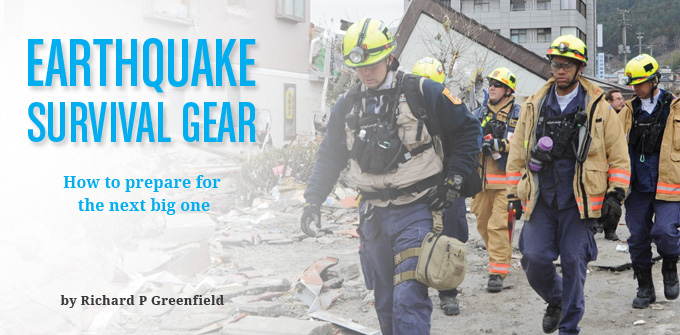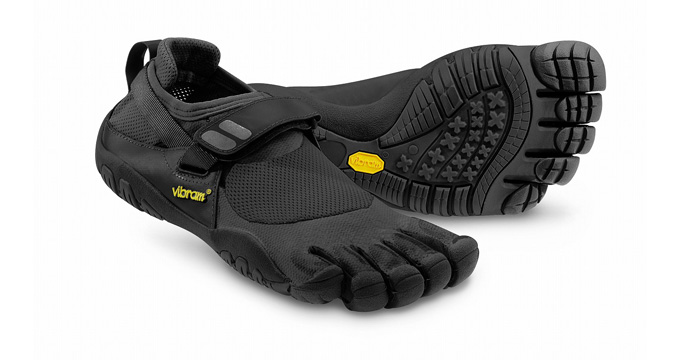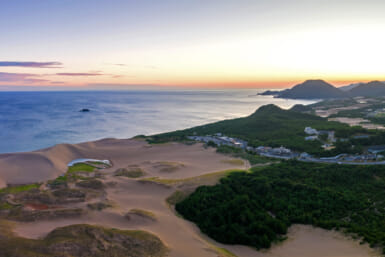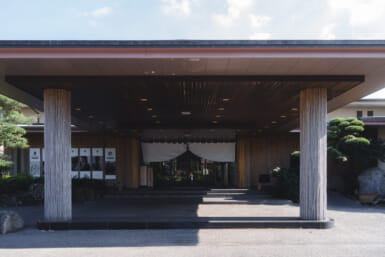by Richard P. Greenfield
Here is a sure prediction: the next big quake will not happen at a time that is convenient for you. You will be at work, or on your way home, or out shopping, or sleeping, or in the shower. In the best case, you will have ten minutes or twenty or thirty to decide what to do, in the worst case, you will have seconds. What you have on your feet, in your pockets, and in your reach can increase your chances of survival.
This does not mean tech toys. In the Tohuku Quake, parts of Honshu, including some parts of Tokyo lost all electric power, the mobile phone system overloaded, then collapsed. What people had to rely on was what they had. With that in mind, the following are options that could become very essential.
What you carry in your pockets could save your life:

Let there be light
When the power fails, whether you are indoors or outdoors, the hazards increase. The best solutions right now are the vast array of small LED lights available. Some, are as small as coins, and fit on a key ring, and it is never a bad idea to have a few of those if you are fumbling for a key. For a brighter solution, Inova makes both keyring LEDs and handhelds. Their X5 has 5 LEDs in a recessed position with 3 options for light output. Multi-LED lights are bright enough to see down darkened corridors, staircases, or streets.
Tel: 042-576-9697 • www.platzcorp.jp
Get out of trouble
While most people were not stuck in cars, that is a possibility, and, for that matter, you could be on an airport bus, also in a seatbelt. The SL6 Rescue from SOG-Tool Logic (above) has a fold out belt ripper with a built in LED (so you do not do unintentional surgery on yourself, your loved ones, passengers or neighbors). The other end of the detachable LED has a hardened window punch to exit a vehicle, train or building if necessary.
www.sogshopping.com
Tool Logic credit card sized multi-tools
The Survival II (above) has a small serrated edge blade which can cut small obstacles, a red LED (red is better for night vision) and a magnesium alloy fire starter.
www.sogshopping.com
 Pocket Space is Limited
Pocket Space is Limited
Very few jackets offer much more in the way of functional pockets that can carry gear. One way around that problem is a good vest with many pockets. Itmay not be suitable formal office wear, but most are light enough to be carried and the best offer more room than a sling bag or a briefcase. Orvis constantly updates and improves its vests. They ship to Japan. The Ultimate Travel Vest is lightweight and has 20 outside pockets and 5 inside pockets which should be enough to hold your gear, your mobile-smart phone, keys, LEDs, in fact everything but your i-pad or laptop (which, in an emergency, you may have to leave behind). If you need more pockets than this, you may be carrying too much.
www.orvis.com
It may be necessary to have a knife
It may be necessary to have a knife particularly a strong lock blade that can be used for cutting or prying. In that case, again, there are many choices. SOG, like Orvis below constantly updates and improves its knives. I have owned a Sogwinder for over 20 years and it has been around the world with me many times. SOG now offers several different knives, some made in Japan. The SOG Vulcan is a lock blade with a proprietary lock system, a hardened case and a core laminated steel blade. www.sogshopping.com
These Shoes are Made for Walking
An NHK survey taken in April showed that 30 percent of the people who were stuck on March 11th walked home. Multiply that by a few million times two and that equals a lot of sore feet, especially given that most people do not go to work in the most comfortable or durable shoes.
Vibram, a company well known for its durable soles (they also make soles for the boots used by the elite Italian mountain troops) has a solution to that. The company has been involved in the bare naked running trend, and now makes shoes that are very lightweight but that have tough Vibram soles at the bottom. The shoes weigh less than many pairs of slippers, and thus can be carried, or a pair can be placed in a work desk or even by a bed. They are not paratrooper boots or Doc Martens but you can get them on a lot quicker, and they will hold up on that walk home.
Should I stay or should I go?
Once you make it home or ride it out at home, if the building is intact, the next decision is go or stay. It may not be simple. Large parts of Kanto lost power for at least a day, some longer. Stores ran out of staples early, and were forced to remain closed due to power outages (some opened, but with limited hours and limited stock).
Staying where you are means, simply, you must have enough food and water, or access to both. Leaving means you have to head somewhere where you will have both food and water
If you stay, both food and water have to be stockpiled. In a major earthquake power to water pumps or the water mains themselves may break. Bottled water was one of the first things to disappear from store shelves and in the greater Kanto area, it was rationed (one bottle per adult) for over a month post-quake.
One of the best ways to stockpile the larder is by shopping online. Prices are often cheaper, even with shipping, and selection is better.
iHerb.com has a large grocery section with many staple foods: canned soups, pastas, crackers and flatbreads, a huge number of cereals (mueslis, granolas, farinas and oatmeals), dried fruits, pancake and waffle mixes, etc. iHerb also stocks many lines of vitamins, multivitamins and mineral supplements. After any large scale disaster, there are always concerns about whether people are getting adequate vitamins and minerals. iHerb drops ship into Japan and they have a special department to take orders and inquiries from Japan.
Only for the Hardcore
For those who want to go hard core, The Ready Store (www.thereadystore.com) has products with shelf lives ranging from 2-5 years. However, the site does not take orders from outside the United States. To use it, it is necessary to use a re-mailing services (there are now many, and they compete on rates) so that an order can be shipped to a “U.S. address” and then forwarded on to you.
Richard P. Greenfield is a journalist based in Japan.











